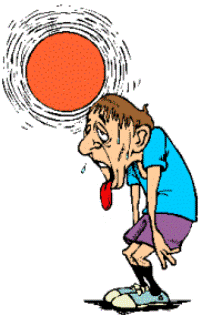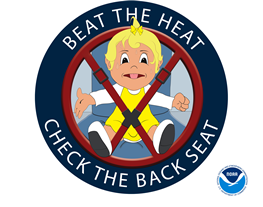
Heat is one of the leading weather-related killers in the United States, resulting in hundreds of fatalities each year. It is important to know how to prevent heat-related illness and how to avoid it.
- Preventing Heat-Related Illness
- Stages of Heat-Related Illness
- General Care for Heat Emergencies
- Never Leave Children, Disabled Adults, or Pets in Parked Vehicles
Preventing Heat-Related Illness
- Dress for the heat. Wear lightweight, light-colored clothing. Light colors will reflect away some of the sun’s energy. It is also a good idea to wear hats or to use an umbrella.
- Drink water. Carry water or juice with you and drink continuously even if you do not feel thirsty. Avoid alcohol and caffeine, which dehydrate the body.
- Eat small meals and eat more often. Avoid foods that are high in protein which increase metabolic heat.
- Avoid using salt tablets unless directed to do so by a physician.
- Slow down. Avoid strenuous activity. If you must do strenuous activity, do it during the coolest par part of the day, which is usually in the morning between 4:00 a.m. and 7:00 a.m.
- Stay indoors when possible.
- Take regular breaks when engaged in physical activity on warm days. Take time out to find a cool place. If you recognize that you, or someone else, is showing the signs of a heat-related illness, stop activity and find a cool place. Remember, have fun, but stay cool.
- How to prepare if your community is having a heat wave: Heat Wave Safety Checklist (provided by American Red Cross)
Stages of Heat-Related Illness
Heat-related illness usually comes in stages. Signs of the first stage is heat cramps in muscles. These cramps can be very painful. If you are caring for a person who has heat cramps, have him or her stop activity and rest. If the person is fully awake and alert, have him or her drink small amounts of cool water or a commercial sports drink. Gently stretch the cramped muscle and hold the stretch for about 20 seconds, then gently massage the muscle. Repeat these steps if necessary. If the victim has no other signs of heat-related illness, the person may resume activity after the cramps stop.
Signs of the next, more serious stage of heat-related illness (often called heat exhaustion) include:
- Cool, moist, pale skin (the skin may be red right after physical activity)
- Headache
- Dizziness and weakness or exhaustion
- Nausea
- The skin may or may not feel hot
Signs of late stage of heat-related illness (often called heat stroke) include:
- Vomiting
- Decreased alertness level or complete loss of consciousness
- High body temperature
- Skin may still be moist or the victim may stop sweating and the skin may be red, hot and dry
- Rapid, weak pulse
- Rapid, shallow breathing
This late stage of a heat-related illness is life threatening. Call 9-1-1.

General Care for Heat Emergencies
- Cool the Body
- Give Fluids
- Minimize Shock
For heat cramps or heat exhaustion: Get the person to a cooler place and have him or her rest in a comfortable position. If the person is fully awake and alert, give a half glass of cool water every 15 minutes. Do not let him or her drink too quickly. Do not give liquids with alcohol or caffeine in them, as they can make conditions worse. Remove or loosen tight clothing and apply cool, wet cloths such as towels or wet sheets. Call 9-1-1 if the person refuses water, vomits or loses consciousness.
For heat stroke: Heat stroke is a life-threatening situation! Help is needed fast. Call 9-1-1. Move the person to a cooler place. Quickly cool the body. Wrap wet sheets around the body and fan it. If you have ice packs or cold packs, wrap them ina cloth and place them on each of the victim’s wrists and ankles, in the armpits and on the neck to cool the large blood vessels (do not use rubbing alcohol because it closes the skin’s pores and prevents heat loss). Watch for signs of breathing problems and make sure the airway is clear. Keep the person lying down.
Never Leave Children, Disabled Adults or Pets in Parked Vehicles

Each year, dozens of children and untold numbers of pets left in parked vehicles die from hyperthermia. Hyperthermia is an acute condition that occurs when the body absorbs more heat than it can handle. Hyperthermia can occur even on a mild day. Studies have shown that the temperature inside a parked vehicle can rapidly rise to a dangerous level for children, pets and even adults. Leaving the windows slightly open does not significantly decrease the heating rate. The effects can be more severe on children because their bodies warm at a faster rate than adults.
How fast can the sun heat a car?
The sun’s shortwave radiation heats objects that it strikes. For example, a dark dashboard or seat can easily reach temperatures in the range of 180 to over 200°F. These objects (e.g., dashboard, steering wheel, child seat) heat the adjacent air by conduction and convection and also give off long-wave radiation which is very efficient at warming the air trapped inside a vehicle.
Safety Tips Concerning Children
- Make sure your child’s safety seat and safety belt buckles aren’t too hot before securing your child in a safety restraint system, especially when your car has been parked in the heat.
- Never leave your child unattended in a vehicle, even with the windows down.
- Teach children not to play in, on, or around cars.
- Always lock car doors and trunks–even at home–and keep keys out of children’s reach.
- Always make sure all children have left the car when you reach your destination. Don’t leave sleeping infants in the car ever.
Information on Heat-Related Illness was provided by the American Red Cross, www.redcross.org and the National Weather Service, www.noaa.gov
